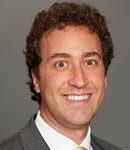Eliot Bencuya aims to amass an institutional-size portfolio comprising assets that often don’t appeal to institutional investors.
Bencuya is the co-founder and newly installed CEO of a non-traded REIT that does business as stREITwise. The online investment platform, launched in 2017, is a wholly-owned subsidiary of Los Angeles-based real estate investment firm Tryperion Partners LLC. Clients of Tryperion include foundations, family offices and high-net-worth (HNW) investors.
The REIT currently owns about $45 million worth of property—an office complex in Sunset Hills, Mo., a suburb of St. Louis, that’s anchored by the global headquarters of Panera Bread Co. Other tenants at the 290,000-sq.-ft., class-A office park—now dubbed stREITwise Plaza—include New Balance, Wells Fargo and Edward Jones.
The REIT’s executives hope to double the size of its portfolio to around $90 million in 2019 through the acquisition of office buildings in the range of $10 million to $40 million, Bencuya says. Non-coastal markets represent the sweet spot of stREITwise’s investment strategy.
“We want to be known as a big fish in a little pond, as opposed to a little fish in a big pond,” he says.
Aside from its non-coastal approach, stREITwise separates itself from other non-traded REITs by charging upfront fees of 3 percent, which is lower than average, as well as low asset management fees (2 percent).
Both accredited and non-accredited investors can invest in stREITwise. Since its inception, the REIT has generated annualized quarterly dividends of 10 percent.
Today, stREITwise concentrates primarily on secondary office markets in non-coastal locations where what Bencuya calls the “suburban-urban thesis” is at play. Under this thesis, he explains, large suburban office campuses are embracing the types of amenities that had mostly been the hallmark of urban office campuses. For stREITwise, that focus “is going to continue for years,” Bencuya says.
In a conversation with NREI, Bencuya outlines the philosophies behind the somewhat contrarian strategies of stREITwise.

NREI: Which non-coastal markets are you keeping an eye on?
Eliot Bencuya: The ones that are doing the most interesting things in regard to the suburban-urban thesis are places like Indianapolis, Minneapolis, Kansas City and Phoenix. And we do own property in St. Louis, and St. Louis is also a focus of ours. We look at any non-coastal market, but those markets seem to be a little bit more ahead of their time in really internalizing the suburban-urban thesis into their growth pattern.
NREI: What is it about these non-coastal markets that holds more appeal than hotspots like Austin, Denver and Nashville?
Eliot Bencuya: Austin, Denver and Nashville are wonderful markets, and they are priced as such. They have capital coming in from not just domestic sources, but foreign sources, and the yields have already compressed in those markets to reflect the growth. We think there’s an opportunity in that next tier of non-coastal markets where you can still acquire properties and earn a higher cash-on-cash return than you could in markets like Austin and Denver and Nashville, but still have that potential for growth. I don’t foresee Kansas City becoming the next Denver, but I also don’t think the prices that Kansas City properties have versus Denver properties are properly reflecting that difference.
NREI: Some investors have shied away from the office sector. Why is that your current focus?
Eliot Bencuya: Industrial and multifamily have been the darlings of the institutional capital markets for the last two years, and the cap rates reflect that, even in secondary markets and even if you’re buying lower quality assets. I don’t think the office asset class in these non-coastal markets has sufficiently drawn enough interest from the institutional capital base yet, so there is still an opportunity for us to capture a higher yield.
NREI: When you’re looking for office assets, what are some of the characteristics you’re seeking?
Eliot Bencuya: What we are really focused on is quality revenue. I don’t think there a lot of investors in this market who are looking at the stickiness of the revenue—they’re not differentiating on the basis of the sustainability and durability of the rent stream. We are looking for quality tenants with long lease terms in locations that, in the event that a tenant were to leave, [they] would be replaceable fairly quickly. In the worst-case scenario—that we do get a vacancy—we are looking for a location that tenants are flocking to.
NREI: What do you think 2019 holds for the office market?
Eliot Bencuya: Our target markets have been very tight. Demand from tenants has been strong. Supply has come on-line, but not has been as effective as you would find in markets such Austin, Denver and Nashville. What you’re seeing is that these markets have incredibly low vacancy rates. I don’t know the extent to which they can sustain their historically low vacancy rates. But I don’t foresee the vacancy rates in these markets rising materially. I still think these markets exhibit strength. I think rents will continue to push up in the strong locations within these markets.

